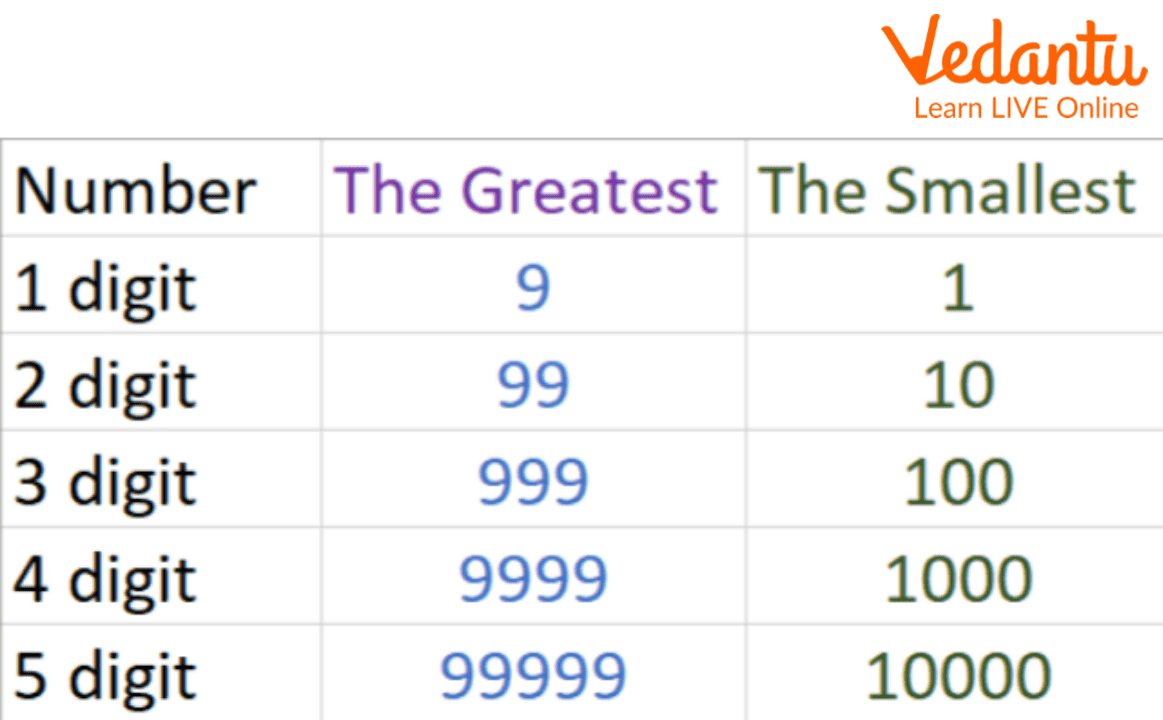




How to Identify the Smallest and Greatest Number in a Set
The smallest number in maths is 1. There is no end to numbers in mathematics. In mathematics, 1 is the smallest number and the largest number has no end. Apart from this, there are many other numbers in mathematics such as composite numbers, prime numbers, etc.

One-Digit Number: Smallest and Greatest Number
The Smallest 1 digit number is 1 and the Greatest one-digit number is 9. Based on this, we can find whatever number we want to find from the smallest number to the greatest number.

Name of the Chapter: The Smallest and Greatest Number
How to Find the Smallest and the Greatest Number of any Digit?
The smallest 2-digit number will become 10 and the largest number will become 99 To make or write the smallest number we write a zero next to one becomes the smallest 2-digit number so on. To write the smallest number, write two zeros next to one, and then it will become the smallest number of three digits. Similarly, if you want to write the smallest number of 4 digits, 5 digits, 6 digits, and 9 digits, after writing one, write zero so many times that the number of digits becomes.
Like the smallest 8-digit number will be 10000000 as it is written 7 times zero after one.
Similarly, you can write the smallest number of any digit to write that number after writing one so much zero should be made that it becomes that number of digits.
Similarly, the Greatest number of any digit can also be written as the Greatest two-digit number is 99 in this you will see that 9 is written 2 times. That is, you can know that to write the largest number as many times as 9 is written then it will become the largest number of that digit e.g. the largest number of 8 digits will be 99999999, it will be the largest number of 8-digit numbers. Now that I understand how to write the smallest number and the largest number.

Smallest and Greatest Numbers Chart
Solved Questions
Which is the smallest number?
Ans: 1 is the smallest number.
Which is the smallest whole number?
Ans: 0 is the smallest whole number.
What is the largest two-digit natural number(a part of the number system, which includes all positive integers from 1 to infinity)?
Ans: 99 is the largest two-digit number.
What is the smallest 3-digit number?
Ans: 100 is the smallest 3-digit number.
What is the smallest even number(Such natural numbers which are exactly divisible by 2)?
Ans: 2 is the smallest even number.
Summary
First of all, we know which is the smallest number of one digit and which is the largest number, which is known, then based on this, we can find the smallest and largest number of any digit. The smallest one-digit number is 1 and the largest one-digit number is 9. Based on this, we can find whatever number we want to find from the smallest number to the greatest number.
Learning by Doing
Write True or False.
The infinity of numbers exists.
99999 is the largest 4-digit number.
9 is the largest single-digit number.
999999999 is the largest 7-digit number.
FAQs on Smallest and Greatest Number Explained for Students
1. What is the basic rule to find the smallest or greatest number from a given group?
To find the greatest number, first compare the number of digits. The number with more digits is always greater. If two numbers have the same number of digits, you must compare their leftmost digits. The number with the larger leftmost digit is greater. If those are also equal, you move to the next digit on the right and repeat the process until you find a difference.
2. How do you form the greatest and smallest number using a given set of digits without repetition?
To form the greatest number, arrange the given digits in descending order (from largest to smallest). To form the smallest number, arrange the digits in ascending order (from smallest to largest). However, there is one important exception: if '0' is one of the digits, it cannot be placed at the beginning of the smallest number. In that case, you should place the second-smallest digit first, followed by 0.
3. What is the smallest one-digit whole number and the greatest one-digit number?
The smallest one-digit whole number is 0. The greatest one-digit number is 9. All single-digit numbers (0, 1, 2, 3, 4, 5, 6, 7, 8, 9) fall within this range.
4. Can you provide an example of forming the smallest and greatest 4-digit number using 1, 8, 0, and 3?
Yes. Using the digits 1, 8, 0, and 3:
- To form the greatest 4-digit number, arrange the digits in descending order (8, 3, 1, 0). The number is 8,310.
- To form the smallest 4-digit number, arrange them in ascending order (0, 1, 3, 8). Since a 4-digit number cannot start with 0, swap 0 with the next smallest digit (1). The number is 1,038.
5. Why can't the digit '0' be the first digit when forming the smallest multi-digit number?
The digit '0' cannot be the first digit because it would reduce the number of digits, changing the value of the number. For instance, if you form a number with the digits 0, 2, and 4 as '024', it is read as 24, which is a two-digit number, not a three-digit number. To maintain the required number of digits, the first digit must be a non-zero digit.
6. How does the concept of smallest and greatest number change when dealing with negative integers?
With negative integers, the rules are reversed. A number with a larger numeral value is actually smaller. For example, -500 is smaller than -50. The further a number is from zero on the left side of the number line, the smaller its value. Therefore, the greatest negative integer is -1, as it is closest to zero.
7. What is the importance of understanding the smallest and greatest numbers in real life?
Understanding the smallest and greatest numbers is a fundamental mathematical skill with many practical applications, such as:
- Financial Decisions: Comparing prices to find the smallest cost (best deal) or greatest return on investment.
- Data Interpretation: Identifying the highest and lowest values in a set, like temperatures in a weather forecast or scores in a test.
- Arranging Information: Sorting data in ascending or descending order, for example, ranking students by marks.
8. Is there a largest number in mathematics? Explain why or why not.
No, there is no single 'largest number' in mathematics. This is because numbers are infinite. For any number you can imagine, no matter how big, you can always create a larger one by simply adding 1 to it. This principle shows that the number system extends forever without an upper limit.















